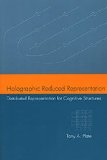

 |

|

The average rating for Holographic Reduced Representation: Distributed Representation for Cognitive Structures based on 2 reviews is 5 stars.
Review # 1 was written on 2015-06-22 00:00:00 Marcus Baffoe Marcus BaffoeI usually love Springer volumes... It wasn't that this book totally kicked my ass/humiliated me... I mean, the exercises were (for the most part) quite well-structured and clear. And Lawry spent a good 40+ pages on the topic of fuzzy sets/identification of vague concepts (LA, LE {described recursively} [i:] L ∈ LE, ∀ L ∈ LA; [ii:] If θ, ᵠ ∈ LE then ¬θ, θ ⋀ ᵠ, θ ⋁ ᵠ, θ '> ᵠ ∈ LE), etc. So what's the problem? 1. This book is dense as hell. I mean that. And the superfluity of the comments/remarks at the end of certain proofs (and before certain exercises and chapters) really stifles the flow (if there was a "flow" to begin with in this text...) of the material presented. {1.1} Lawry needlessly repeats himself: In this case it can easily (be)* seen that the associated calculus of membership (fixed point coverage) functions will, in general, be neither functional or truth-functional. This sort of calculus would satisfy the standard Boolean laws. Certainly such a calculus would satisfy the standard Boolean laws (of idempotence, law of excluded middle, and the law of non-contradiction.) What is the point of that? That adds ABSOLUTELY NOTHING to the problem. {1.2} There are typographical errors fucking EVERYWHERE. Springer needs to check their shit before selling it for $140. {1.3} Some of the examples/metaphors are unbelievably stupid/annoying. {1.4} This book (with its stiff, Manila-like paper) gave me a total of eight paper cuts. These itched (terribly). OK. Now that we have the bulk of the problems/complaints out of the way, let's talk about why this book was given three stars (which would imply that it's a "good" book): The section on voting and context model semantics was absolutely gorgeous, and, as a result of that, almost made me award an extra star... but to do so would be dishonest. As it was one of the few truly clean and rigourous (and subsequently enjoyable) parts of this book. I will certainly credit Herr Lawry with knowing the material. Some of his remarks (that don't get in the way) display an almost unsettling brilliance and command of the subject. Had the text not been so INCREDIBLY CONVOLUTED (that is, had it been edited)... it would've earned five stars (easily). *: Typographical error'word was omitted. Added in for clarification purposes. |
Review # 2 was written on 2012-09-30 00:00:00 James Varnham James VarnhamIt was an interesting read; like many history books, it feels to detailed at times, but this is just the way it is when reading academic books: They go the steps to make sure you understood why the argument is as it is (or at least think you did). The topic was particularly interesting for me as my job is related to databases. I wrote the most annotations for the section on cybernetics. |
CAN'T FIND WHAT YOU'RE LOOKING FOR? CLICK HERE!!!